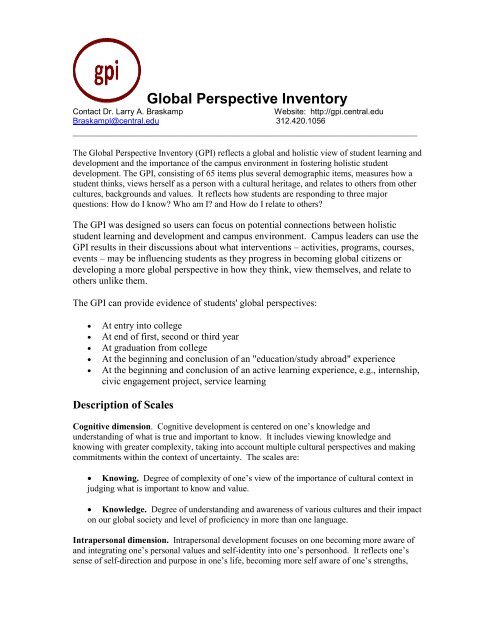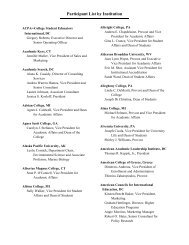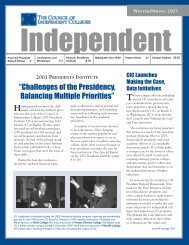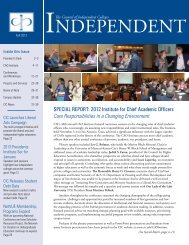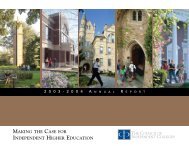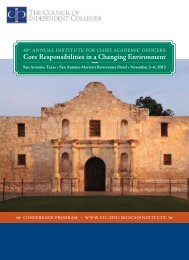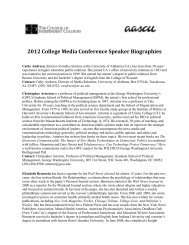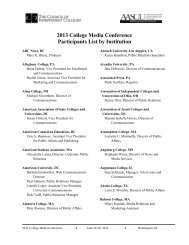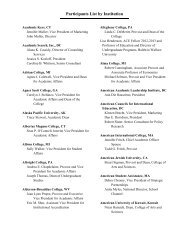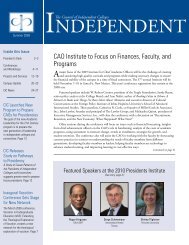Create successful ePaper yourself
Turn your PDF publications into a flip-book with our unique Google optimized e-Paper software.
Contact Dr. Larry A. Braskamp<br />
<strong>Global</strong> <strong>Perspective</strong> <strong>Inventory</strong><br />
Website: http://gpi.central.edu<br />
Braskampl@central.edu 312.420.1056<br />
_______________________________________________________________________<br />
The <strong>Global</strong> <strong>Perspective</strong> <strong>Inventory</strong> (GPI) reflects a global and holistic view of student learning and<br />
development and the importance of the campus environment in fostering holistic student<br />
development. The GPI, consisting of 65 items plus several demographic items, measures how a<br />
student thinks, views herself as a person with a cultural heritage, and relates to others from other<br />
cultures, backgrounds and values. It reflects how students are responding to three major<br />
questions: How do I know Who am I and How do I relate to others<br />
The GPI was designed so users can focus on potential connections between holistic<br />
student learning and development and campus environment. Campus leaders can use the<br />
GPI results in their discussions about what interventions – activities, programs, courses,<br />
events – may be influencing students as they progress in becoming global citizens or<br />
developing a more global perspective in how they think, view themselves, and relate to<br />
others unlike them.<br />
The GPI can provide evidence of students' global perspectives:<br />
• At entry into college<br />
• At end of first, second or third year<br />
• At graduation from college<br />
• At the beginning and conclusion of an "education/study abroad" experience<br />
• At the beginning and conclusion of an active learning experience, e.g., internship,<br />
civic engagement project, service learning<br />
Description of Scales<br />
Cognitive dimension. Cognitive development is centered on one’s knowledge and<br />
understanding of what is true and important to know. It includes viewing knowledge and<br />
knowing with greater complexity, taking into account multiple cultural perspectives and making<br />
commitments within the context of uncertainty. The scales are:<br />
• Knowing. Degree of complexity of one’s view of the importance of cultural context in<br />
judging what is important to know and value.<br />
• Knowledge. Degree of understanding and awareness of various cultures and their impact<br />
on our global society and level of proficiency in more than one language.<br />
Intrapersonal dimension. Intrapersonal development focuses on one becoming more aware of<br />
and integrating one’s personal values and self-identity into one’s personhood. It reflects one’s<br />
sense of self-direction and purpose in one’s life, becoming more self aware of one’s strengths,
values, and personal characteristics and sense of self, and viewing one’s development in terms of<br />
one’s self-identity. The two scales are:<br />
• Identity. Level of awareness of one’s unique identity, sense of purpose, and degree of<br />
acceptance of one’s identity.<br />
• Affect. Level of respect for and acceptance of cultural perspectives different from one’s<br />
own and degree of emotional confidence when living in complex situations, which<br />
reflects an “emotional intelligence” that is important in one’s processing encounters with<br />
other cultures.<br />
Interpersonal dimension. Interpersonal development is centered on one’s willingness to interact<br />
with persons with different social norms and cultural backgrounds, acceptance of others, and<br />
being comfortable when relating to others.<br />
• Social Responsibility. Level of interdependence and social concern for others.<br />
• Social Interactions. Degree of engagement with others who are different from oneself<br />
and degree of cultural sensitivity in living in pluralistic settings.<br />
Campus Environment<br />
Three dimensions of a campus have been identified having a major influence on student learning<br />
and development (Braskamp, Trautvetter, and Ward, 2006). Each of these dimensions can be<br />
interpreted as one aspect of a campus environment (or education/study abroad program).<br />
• Curriculum focuses on the courses and pedagogy employed by the instructor. It<br />
includes course content (what is taught), pedagogy that reflects local style of teaching and<br />
interactions with students (how content is taught).<br />
• Co-curriculum focuses on the activities out of the classroom that foster student<br />
development. It includes planned interventions, programs and activities such as<br />
organized trips, social and cultural events, residence hall living arrangements, emersion<br />
experiences, and leadership programs.<br />
• Community focuses on the relationships among the various constituencies including<br />
students, faculty, and staff to create a sense of camaraderie and collegiality. It includes<br />
the rituals that reflect the traditions and legacies, habits of staff and faculty with their<br />
interactions with students, rules and regulations, and physical setting. It also includes<br />
relationships colleges (or study abroad programs) have with external and local<br />
community agencies, schools, and churches.<br />
GPI Authors: Braskamp, L.A., Braskamp, D.C., Merrill, K., & Engberg, M. E.<br />
Copyright © 2010 <strong>Global</strong> <strong>Perspective</strong> Institute Inc.


